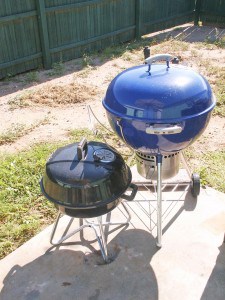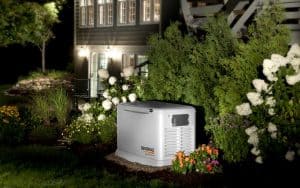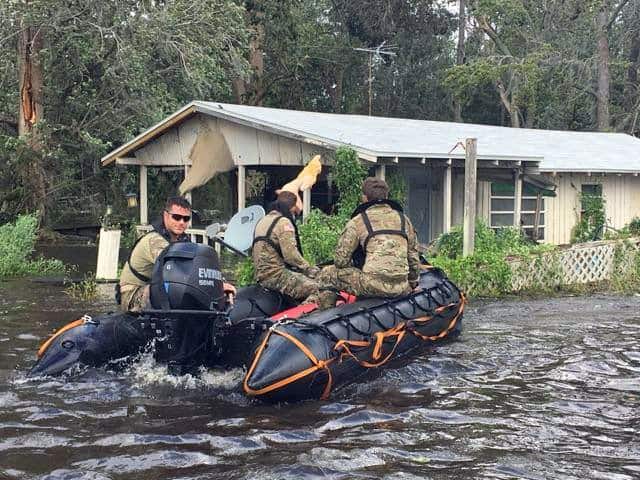Power Outage Cooking Tips—Power Outage Food Safety in Fridge Freezer Cooler
Standby and portable generators are essential appliances during a power outage, but they have their limits. You probably know that your electric range uses a lot power and if air conditioners are running, adding heat to the house with a range adds even more to the electrical load. When the power goes out and you’re using standby power for essentials and conveniences, you need other options for cooking food.
Portable generators add even more limits to your options. Unless you connect them to the house with a manual transfer switch, appliances that are hard wired won’t have power. Some appliances like over-the-range microwaves and refrigerators often have difficult to reach plugs and outlets. Major appliances like refrigerators and freezers or microwave and toaster ovens require heavy duty extension cords.
Generac, the company that brought affordable backup power to homes and small business, has a new product that cuts your energy bills and pays for itself over the life of the system. Generac PWRcell combines Solar Energy with Battery Storage to power the home’s main circuit breaker panel. That means power for the whole home or business and not just a sub panel. A single PWRcell Battery Cabinet with three Battery Modules and the PWRcell Inverter can supply up to 9kW continuous power, nearly twice as much as Tesla PowerWall or LG SolarEdge. PWRcell easily scales from 9kWh to 36kWh of storage capacity. And it can start and run a 3-ton air conditioner. Six modes of operation with The PWRcell ATS including islanding to keep the home or business powered through an outage or blackout. Solar Power at Norwall
Safety First
When you’re pulling out those seldom-used, counter-top cooking appliances for power outage cooking, remember that those short cords serve a purpose. They prevent the cord from hanging off a counter where a child could grab it and pull it down. Appliance cords are also made to handle the amount of power the appliance uses. Don’t overload an extension cord made to power a lamp by using it for a microwave or toaster oven.
Only use extension cords made for appliances, and don’t allow cords to hang where a child could pull the appliance down on top of themselves. Keep extension cords from crossing places where people walk or where they might be stepped on.
And don’t forget, that third prong on the plug is an important safety feature—Don’t use a two-wire extension cord to power an appliance with a three-prong plug.
Don’t forget. You can light most gas range burners with a BBQ lighter or match.
Installation Guide: Home Standby Generator for Emergency Power
Microwave and Toaster Ovens

A Briggs and Stratton Home Standby Generator Supplies Power to Kitchen Appliances and the Entire Home
The appliance cooking power is a good indicator of how much power the microwave uses. Microwaves use up to 40 percent more power than their cooking power, so a 1000-watt microwave uses about 1400 watts. Toaster ovens use from 1200 to 1700 watts, but microwaves cook fast if the food isn’t too thick, so they are a good alternative for heating up convenience foods like hot dogs, frozen dinners, and canned or frozen foods.
The toaster oven is better for cooking meats and will do a better job of browning the meat and cooking it more evenly.
Microwaves and toaster ovens won’t wreck your standby power budget and make good choices for power outage cooking. If you’re using close to the maximum power your backup generator can supply, turn off an air conditioner or other large appliance while you’re cooking dinner, then turn it back on when you finish cooking.
Safe Placement of Portable Generators
Hot Plates

KOHLER generators can power your entire home during outages for cooking, heating and cooling, and home safety.
Hot plates come in single and two burner versions, and on average use between 500 and 800 watts per burner. They are similar to using a small, single coil burner on an electric stove. At less than half what toaster ovens and microwaves use, they work well with both standby and portable generators for cooking food during power outages.
They are safe when used carefully and can be used to boil a pot of water or simmer dinner in a frying pan. They’re great for making oatmeal or cream of wheat, or just heating up a can of vegetables or baked beans. Canned or frozen soups and stews are other good options.
Be sure to place the hot plate where it can’t fall or tip over, and don’t place pots on it that are too large for the burner to support.
Standby Generator Buyer Guide: What Size Generator Do I Need?
Other Cooking Appliances

Grilling Outdoors is Another way to Cook Without Power
Electric fry pans, waffle irons and griddles can use 1000 to 1600 watts, and coffee makers average 1200 watts. They fall into the same energy category as toaster ovens and microwaves. Crock pots and slow cookers are the energy misers at just 200 to 300 watts on average. If you’re using a portable generator, these little gems might take half a day to cook a pot roast, but they’ll do it without overloading your backup generator.
Don’t forget the BBQ grill for power outage cooking. Charcoal and gas grills can do more than grill a few burgers or sausages on a warm summer day. They are perfect for cooking with no power during an outage especially when your backup is a portable inverter generator. Gas and charcoal grills are outdoor appliances―never use them indoors because they emit dangerous carbon monoxide.
An added benefit to using the outdoor grill to cook food during power outages is they don’t add heat to the house which reduces the load on your air conditioners and on your backup power generator.
Top Four Portable Generators for Emergency Power
Power Outage Food Safety

Eggs and other easily perishable foods are at risk during a power outage
Without a backup generator for home use, the temperature inside the fridge during power outage begins to warm immediately upon losing power. At first the increase in temperature is negligible provided the doors stay closed. If the refrigerator started out at 35 degrees, the temperature inside will slowly rise over the next four hours to about 40 degrees, which is the maximum temperature that food remains safe for extended periods of time. As the temperature rises above 40 degrees, food remains safe for about two more hours in the refrigerator. After two hours, throw away any perishable food that requires refrigeration that was not kept cool below 40 degrees.
If the ambient temperature inside the house is over 90, the safe time after the refrigerator reaches 40 degrees is reduced to one hour and the fridge will reach 40 sooner than at lower temperatures.
Above 40 degrees, the bacteria in perishable food that requires refrigeration will begin to grow and multiply rapidly. At room temperature—60 to 80 degrees Fahrenheit, the types of bacteria that cause food poisoning double in number.
Tip: It’s important to monitor your fridge during a power outage. Place a digital refrigerator thermometer on your refrigerator door with a probe that goes inside on the middle shelf. You’ll know without opening the door how cold it is inside the refrigerator. Use a second thermometer on your freezer.
Freezers will remain cold enough to keep food frozen for at least 12 hours provided they are kept closed and are at least half full. Keep gallon jugs of water inside the freezer to use up excess space. The blocks of ice will help keep the temperature down and the food inside frozen. You can also borrow a few to put in a cooler to keep refrigerated food cold.
Read Next: Preparing Meals During an Extended Power Outage
Updated 27 September 2017



















